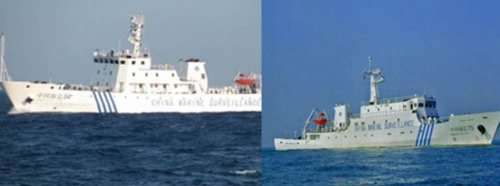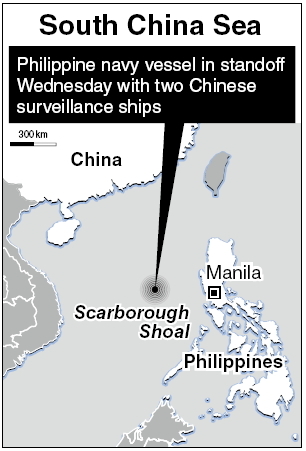 |
This undated handout photo taken by Philippine navy and released on Wednesday by the Department of Foreign Affairs shows a combo photo of Chinese surveillance ships 84 (left) and 75 which were allegedly locked in a standoff with the biggest warship of the Philippines, off Scarborough Shoal, as the Philippines` navy flagship tried to arrest Chinese fishermen found to have illegally entered its territory over the weekend. (AFP-Yonhap News) |
MANILA (AP) -- The Philippine government said Wednesday it agreed with China to diplomatically resolve a tense standoff involving a Philippine warship and two Chinese surveillance vessels in the disputed South China Sea, the most dangerous confrontation between the sides in recent years.
Philippine Foreign Secretary Albert Del Rosario said he met with Chinese Ambassador Ma Keqing and both reaffirmed their governments‘ positions that the Scarborough Shoal where the ships are facing off was part of their own country’s territory and neither was ready to stand down.
Del Rosario said that despite the impasse, "we resolved to seek a diplomatic solution to the issue."
The Philippine government said the standoff began when its navy tried to detain Chinese boats fishing in its waters but was stopped by two Chinese surveillance craft. The Chinese Embassy accused the Philippine warship of harassing the fishermen and called for it to leave Chinese territory.
The South China Sea is home to a myriad of competing territorial claims, most notably the Spratly Islands south of the shoal, an island chain claimed by China, the Philippines, Vietnam, Brunei, Malaysia and Taiwan. The barren islands, reefs and coral outcrops are believed to be in rich in oil and gas and the overlapping claims have long been feared as Asia‘s next flashpoint for armed conflict.
Both China and the Philippines flexed their muscles on Wednesday. Del Rosario said that he warned China’s ambassador that "if the Philippines is challenged, we are prepared to secure our sovereignty."
The Philippine navy was sending additional vessels toward the shoal, which lies about 200 kilometers (124 miles) from the nearest Philippine coast, a Philippine navy official told The Associated Press. He spoke on condition of anonymity because of a lack of authority to discuss the situation with the media.
The standoff began Sunday when a Philippine navy surveillance plane spotted eight Chinese fishing vessels anchored in a lagoon at Scarborough, the Philippine Foreign Affairs Department said. That prompted the military to deploy its largest warship, the BRP Gregorio del Pilar, which was recently acquired from the United States.

On Tuesday, Filipino sailors from the warship boarded the Chinese vessels for an inspection, discovering large amounts of illegally collected coral, giant clams and live sharks inside the first boat. Del Rosario said that the Chinese fishermen had been "engaged in illegal fishing and harvesting of endangered marine species."
Two Chinese maritime surveillance ships later approached and positioned themselves between the Philippine warship and the Chinese fishing vessels "thus preventing the arrests of the erring Chinese fishermen," the Philippine statement said.
The Chinese Embassy said the fishing boats had taken shelter from a storm in the lagoon, and that Philippine troops including some who were armed went into the lagoon and harassed the fishermen.
"Two Chinese marine surveillance ships are in this area fulfilling the duties of safeguarding Chinese maritime rights and interests," it said in a statement.
It said the shoal "is an integral part of the Chinese territory and the waters around it the traditional fishing area for Chinese fishermen."
Last year, the Philippines accused Chinese vessels of intruding into other parts of what it considers Philippine territory in the South China Sea. China has regularly dismissed the protests, saying Beijing has indisputable sovereignty over those areas on historical grounds.
The United States has insisted it takes no sides in the territorial dispute but says it should be solved peacefully. China has balked at what it considered a U.S. interference in the region.
The disputes over the Spratlys have settled into an uneasy standoff since the last major clash involving China and Vietnam killed more than 70 Vietnamese sailors in 1988..









